Adventures in

|
This story was written down in 1958 by my late Great-grandfather, Louis Daniel Spaulding, who, as a young man early in the Twentieth Century, worked at Bob Montgomery's mile-high gold mill in the mining camp of Skidoo, in the Panamint Mountains in Death Valley country. The mill was powered principally by water, which flowed by gravity through a 23-mile pipeline (whence the name "Skidoo") from Birch Spring, high on the west side of Telescope Peak.
Here, he tells of his adventures as he traveled to Skidoo and worked in the mill, and of how he walked 62 miles across Death Valley with an injured hand from Skidoo to Rhyolite, Nevada, on Christmas, 1909. |
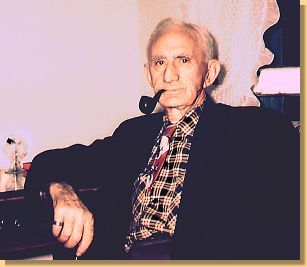 Louis Daniel Spaulding in 1958 |
(Click on the thumbnail pictures below to view the full-size photos)
THE AMALGAMATOR - SKIDOO, 1909
By Louis Daniel SpauldingIn the early days of lode gold mining, stamp mills were used for crushing the ore. Where there was free gold in the ore, a silver-plated copper plate was placed so that the discharge through the screen from the mortar, with the addition of water, flowed down over this plate which was coated with quicksilver, allowing the free gold to become amalgamated and retained on the plate. The man who operated such a mill was called an amalgamator.
In September of 1909, Bob Montgomery came to my home to discuss sending me to Skidoo to run his mill. He had learned from his chauffeur, a friend of mine (Cecil Loomis), that I was an amalgamator. Arrangements were made for me to go to his office the following Monday to care for financing the trip. He advanced me fifty dollars and the pay for my services was agreed upon as seven dollars a day and board. I took the train from Los Angeles to Barstow, where I transferred to a combination train to Johannesburg. From there I went by stage to Ballarat. The distance was seventy-two miles, past Searles Dry Lake at which point the horses were exchanged. While this was being done, I talked with the man on the front porch of the station shack. Hanging by bailing wire wrapped around the bare plant was a small cactus with a single reddish pink blossom on it. The man told us that Mr. Searles himself had hung it there fifteen years before, and now was the first time it had blossomed or shown any sign of life. He figured the desert air contained more moisture this particular year.
Arriving at Ballarat, which at that time had a store, post office, restaurant and hotel I made arrangements for bed, meals etc. At six in the morning, having had breakfast, I was on the stage as sole passenger with Ed Robinson, stage driver for Skidoo. The trip was through Wild Rose Canyon by way of Harrisburg Flat, a distance of 43 miles. I amused myself on the way shooting at coyotes with a Colt automatic pistol. We got into Skidoo just at dusk.
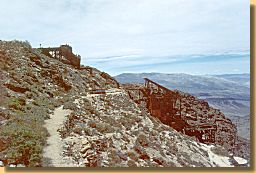 I had been downspirited because of having left a year-old baby who was becoming dear and interesting to me, and also the thought that there would be no one at Skidoo whom I had previously known. (A coincidence was that my wife had been born in Virginia City, and the daughter in Searchlight, Nevada, where I had been an amalgamator in the Quartette Mill.) As I got off the stage, the first person I saw was Austin Young, who had been postmaster in Randsburg and was now the Skidoo postmaster. Also I talked with a miner I had known previously who was later killed at the Arondo mine. I was driven to the mine about a half a mile further and met Bob's superintendent, Al Davis. I had my supper at the mine boarding house, which employed a middle-aged lady who had been a registered nurse. There was also a younger woman for dishwashing and a handyman, a young man in his early twenties named Potts.
I had been downspirited because of having left a year-old baby who was becoming dear and interesting to me, and also the thought that there would be no one at Skidoo whom I had previously known. (A coincidence was that my wife had been born in Virginia City, and the daughter in Searchlight, Nevada, where I had been an amalgamator in the Quartette Mill.) As I got off the stage, the first person I saw was Austin Young, who had been postmaster in Randsburg and was now the Skidoo postmaster. Also I talked with a miner I had known previously who was later killed at the Arondo mine. I was driven to the mine about a half a mile further and met Bob's superintendent, Al Davis. I had my supper at the mine boarding house, which employed a middle-aged lady who had been a registered nurse. There was also a younger woman for dishwashing and a handyman, a young man in his early twenties named Potts.
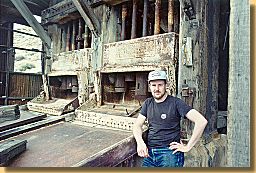 It was agreed that I would take up my duties the second day following. I was to replace a man who had become careless and was losing amalgam from the plates. I was given a room in the house which had a bed, chair, water pitcher, and basin. As I had a sailor's hammock with me, I decided to sleep in that. It was a bad idea, for one of the supports broke in the night giving me a painful fall. In the morning I had breakfast and went down to look over the mill which was eight or nine hundred feet down in a steep gulch below the office.
It was agreed that I would take up my duties the second day following. I was to replace a man who had become careless and was losing amalgam from the plates. I was given a room in the house which had a bed, chair, water pitcher, and basin. As I had a sailor's hammock with me, I decided to sleep in that. It was a bad idea, for one of the supports broke in the night giving me a painful fall. In the morning I had breakfast and went down to look over the mill which was eight or nine hundred feet down in a steep gulch below the office.
The mill was fifteen, ten-hundred-and-fifty pound stamps, run by a Doble type water wheel without a governor. It was possible to walk under the floor on which the amalgam plates were located. Under here was a Continental gas engine with hit-and-miss type governor. This engine by a belt could be hooked to a line shaft to give additional power when crushers on the upper floor were operating. It also served when thus hooked up to a certain extent to govern the water power.
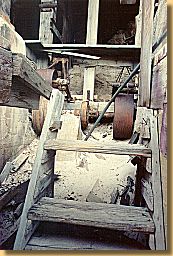 I began immediately to improve amalgamation, and with the help of Fred Davis, the superintendent's brother, to make repairs to the mill. I cleaned up twice a month and recovered from nine to fourteen thousand dollars each clean-up. We had some trouble with the pipeline, which was twenty-three miles long coming from Telescope Peak. It was broken once while it lay on the surface near the mill.
I began immediately to improve amalgamation, and with the help of Fred Davis, the superintendent's brother, to make repairs to the mill. I cleaned up twice a month and recovered from nine to fourteen thousand dollars each clean-up. We had some trouble with the pipeline, which was twenty-three miles long coming from Telescope Peak. It was broken once while it lay on the surface near the mill.
I had only made one clean-up when Mr. Montgomery sent word to Al Davis to put me in charge of the mill. An amusing but rather dangerous accident happened in the assay office one day. It is the custom to take the sponge gold after retorting away the mercury, and placing it with proper flux into a plumbago crucible. The old one looked rather weak, so there being a new mate to it, I used the new one. When the gold is thoroughly melted it is poured into four-pound bricks, as at this time the post office would not transport larger sizes. This crucible would hold about two-and-a-half or three gallons of liquid. The method of handling is shown here: One man on each handle, protected by long gauntlet asbestos gloves, would lift the crucible, thus pouring the gold into one mold after the other. The ring in this case was not tight enough. The crucible tipped out of the ring and upside down, spilling the molten gold on the concrete floor where it ran in every direction. The superintendent, who was helping me, and I had to step lively to escape the molten gold from striking against our feet, as it would have burned right through the sides of our shoes. Afterwards we used a smaller crucible which could be handled with tongs by one man.
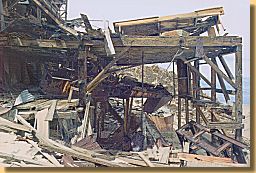 Another amusing incident occurred at the mill. We were operating two twelve-hour shifts. I had replaced the other amalgamator with a new man named Perch Douglas, who not only was a capable man but very conscientious. I had been in the habit of carrying balls of amalgam in a large iron pot up to the main office safe, but it being very heavy, I decided rather to hide it in a large carpenter and tool box in the mill. Hiding it for the first time under the tools and locking the box with a padlock, I forgot that Perch might have to use tools during the night and I failed to mention it to him. In the morning when I relieved him he said that during the night he had needed tools and was quite miffed. When I told him why and upon showing him the several thousand dollarsí worth of amalgam, he said if he had known it he would have been worried all night for fear of being knocked on the head and robbed.
Another amusing incident occurred at the mill. We were operating two twelve-hour shifts. I had replaced the other amalgamator with a new man named Perch Douglas, who not only was a capable man but very conscientious. I had been in the habit of carrying balls of amalgam in a large iron pot up to the main office safe, but it being very heavy, I decided rather to hide it in a large carpenter and tool box in the mill. Hiding it for the first time under the tools and locking the box with a padlock, I forgot that Perch might have to use tools during the night and I failed to mention it to him. In the morning when I relieved him he said that during the night he had needed tools and was quite miffed. When I told him why and upon showing him the several thousand dollarsí worth of amalgam, he said if he had known it he would have been worried all night for fear of being knocked on the head and robbed.
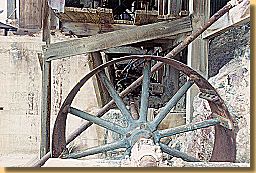 Things went along almost in a routine way until a day or so before Christmas when I had trouble with the gas engine having a tendency to run away. I had a pair of pliers for which I had sent to Chicago, similar to Model-T Ford pliers, with one handle having a screwdriverís edge on it, and which cost me forty-five cents. I attempted to make an adjustment on the governor without stopping the engine. There was a weight about four inches in diameter and two inches thick on one spoke of the flywheel. This was a part of the governor mechanism. In some manner it struck the pliers and drove the screwdriver handle into the center of the palm of my right hand. I had a sharp pain in the back of my right hand, and thinking it had knocked my hand against the hood of the engine and knocked the pliers from my hand, I began looking for them on the floor; suddenly I discovered that they were still sticking in my hand, and had to put them in a vice on the work bench and pull my hand off from them.
Things went along almost in a routine way until a day or so before Christmas when I had trouble with the gas engine having a tendency to run away. I had a pair of pliers for which I had sent to Chicago, similar to Model-T Ford pliers, with one handle having a screwdriverís edge on it, and which cost me forty-five cents. I attempted to make an adjustment on the governor without stopping the engine. There was a weight about four inches in diameter and two inches thick on one spoke of the flywheel. This was a part of the governor mechanism. In some manner it struck the pliers and drove the screwdriver handle into the center of the palm of my right hand. I had a sharp pain in the back of my right hand, and thinking it had knocked my hand against the hood of the engine and knocked the pliers from my hand, I began looking for them on the floor; suddenly I discovered that they were still sticking in my hand, and had to put them in a vice on the work bench and pull my hand off from them.
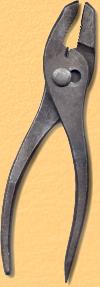 I left the mill in Fredís care and went up to the mine office, where we had a first aid kit. The strongest antiseptic we had was Peroxide of Hydrogen. I cleaned and dosed my hand with this and Al wrapped it up for me. That evening Mrs. Davis roasted an onion which I placed on the hand, but I slept very little that night, and in the morning had a terribly swollen hand. Our doctor had gone prospecting, so Al Davis advised me to take the stage to a doctor at Randsburg. As it was seven below zero in the morning and there was a foot and a half of snow on the ground, I decided against that.
I left the mill in Fredís care and went up to the mine office, where we had a first aid kit. The strongest antiseptic we had was Peroxide of Hydrogen. I cleaned and dosed my hand with this and Al wrapped it up for me. That evening Mrs. Davis roasted an onion which I placed on the hand, but I slept very little that night, and in the morning had a terribly swollen hand. Our doctor had gone prospecting, so Al Davis advised me to take the stage to a doctor at Randsburg. As it was seven below zero in the morning and there was a foot and a half of snow on the ground, I decided against that.
Young Potts had been wanting to go for a short vacation to Los Angeles, so I persuaded Al Davis to let him go with me, and we would walk the sixty-two miles to Rhyolite, Nevada, crossing Death Valley. We carried a small coffee pot, frying pan and a small amount of food, and each of us had a two-gallon canteen of water, and me with my pockets full of onions.
We arrived at Stovepipe Wells by dark. There was only an un-roofed adobe house with a dirt floor, and the so-called well, a hole probably four feet deep and fourteen inches in diameter. We did not use the water from this well, which was heavily impregnated with arsenic. This place being 4.9 feet below sea level, we slept fairly warm inside the house without blankets, which we could not carry.
In the morning, after making coffee and frying bacon, we started up the other side through the Funeral Range. Several miles up the road we came to Daylight Springs where we refilled our canteens. During both days we stopped every two or three hours to roast an onion and place it, as hot as I could bear it, in the palm of my hand with a bandanna handkerchief for a bandage.
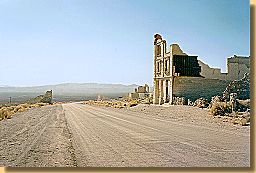 We passed a dozen or so of the old twenty-mule team high-wheeled borax wagons parked off the road. It was very cold out and we were very lucky to catch a ride the last two hours out of Rhyolite with a teamster going our way. As we came into Rhyolite we got off the wagon and went to a two-story frame hotel and got a room upstairs. We had hot water brought up and cleaned the hand. The swelling being gone, I paid no heed to Potts urging that I see a doctor. Potts was hungry but I was cold and do not remember ever feeling colder. After going to a drugstore and having the hand bandaged with antiphlegistine on the wound, we went into a large saloon with two big cherry-red coal stoves, and a long bar with Tom and Jerry bowls along it. I finally got warmed through, and to this day am very fond of Tom and Jerry.
We passed a dozen or so of the old twenty-mule team high-wheeled borax wagons parked off the road. It was very cold out and we were very lucky to catch a ride the last two hours out of Rhyolite with a teamster going our way. As we came into Rhyolite we got off the wagon and went to a two-story frame hotel and got a room upstairs. We had hot water brought up and cleaned the hand. The swelling being gone, I paid no heed to Potts urging that I see a doctor. Potts was hungry but I was cold and do not remember ever feeling colder. After going to a drugstore and having the hand bandaged with antiphlegistine on the wound, we went into a large saloon with two big cherry-red coal stoves, and a long bar with Tom and Jerry bowls along it. I finally got warmed through, and to this day am very fond of Tom and Jerry.
The next day, about two in the afternoon, we left by Tonapah and Tidewater narrow-gage train for Ludlow on the main line of the Santa Fe. We arrived in Ludlow toward midnight, and being informed that the train from the east was delayed by storm, we went to a hotel and to bed, with word to call us. We were called about six in the morning, and as the train was late, the conductor polled the train to find out about stopping for breakfast at Barstow.
We had had no news at Skidoo about the burning of the Harvey House at Barstow, so being a bit slow in getting off, and noticing the crowd going into a restaurant opposite where the depot had been, I therefore went down the street to a large restaurant and sat down at a table, when suddenly I realized it was run by Chinese. Then I noticed a small Chinaman standing beside me, who said, "When you see Jim Hodgeman last?"
I recognized him and told him I was in a hurry, being from the train, and without a word he left. He was back with breakfast for me, apparently remembering the things I liked. I finished my breakfast and went to the counter where the Chinaman was standing, I pushed open the cigar case and took three cigars, placing two in my vest pocket. I was about to cut the other when he took my cigars, and put out a box of Principe do Gales, three for 50¢. Two he placed in my pocket and one he clipped and put in my mouth and lighted it for me. I shoved a silver dollar across the counter and he pushed it back saying, "Your money no good here." I have never seen the Chinaman since, but I would sure like, sometime in God's plan for our souls future, to meet up with this real Chinese gentleman and friend.
I came home to my wife and child, to find the doctor there treating my wife for some slight illness. He told me, after looking at my hand, that I had done as good a job as he could have done, and left me some alum to burn to prevent proud flesh.
I stayed in Los Angeles about a week and had talks with Bob Montgomery, and started back to Skidoo with a new outfit of heavy underwear, socks and shirts, wrapped in a bundle about four feet in length and twelve inches in diameter, wrapped with a new white canvas.
There was a combination train from Barstow to Johannesburg, which had one passenger car that had one end partitioned off for a smoking compartment with two seats facing each other on either side. On one side facing each other were John Singleton, one of the owners of the Yellow Aster Mine, and myself. Similarly, on the opposite side of the car sat Ed Robinson, stage driver from Ballarat to Skidoo, who had been on a short vacation to Los Angeles, and Harry Cheesebrough, whose uncle did a lot of teaming around Randsburg, and also had the mail-carrying contract from Johannesburg to Ballarat.
We all had suitcases, each containing several bottles of whiskey. Harry opened a quart of Sunnybrook and passed it to Ed who in turn passed it to me, each of us taking a drink. I passed it to Mr. Singleton who said, "I donít want your rot gut", but picked up a paper bag containing a bottle which he had sitting on the floor, from which he drank without taking the bottle from the paper bag, so that we could not see what kind of whiskey it was. Each of us carrying a bottle of Sunnybrook, we had several more drinks along the way, each time John refusing and going through the same procedure. Finally, I said, " John, your whiskey is probably no better than ours." Picking up the paper bag and withdrawing the bottle, I saw it was labeled "Sunnybrook", and we all had a hearty laugh at John's expense.
The driver of the stage from Johannesburg to Ballarat was a Chilean Indian named Manuel who would throw out the mail, including the registered sack with gold bullion bars from Skidoo in front of the Joeburg post office and shout, "Here's the mail," without getting a receipt for it until he had come back from taking care of his horses. When we left Johannesburg next morning, the stage was full of men on their way to the Panamint mountains to relocate claims.
There was a great deal of baggage, including my bundle, tied on behind. There being so many men on the stage, immediately on arrival at Ballarat I rushed across the road to get a room, as accommodations there were limited. Then I went back to the post office for my bundle, which was nowhere to be found.
I went back to the hotel and had the proprietor go with me to search the rooms, thinking some of the men had gotten my bundle by mistake. The rest of the men had gone to supper in the dining room. We did not find the bundle, so being late for supper, I took the one remaining chair at the table. On my left was a bleary eyed man, very drunk. He had a large revolver on the table on my side of his plate. He looked at me and kept muttering, "I guess I ought to shoot you." I jollied him along by such remarks as, "you wouldn't shoot a man before he finished his meal," nevertheless keeping a close eye on him so that if he grabbed for the gun, I could prevent him from using it. Finally I finished my supper and was able to go to my room and to bed with no further trouble.
At six in the morning, Ed Robinson and I, having finished our breakfast, went out to start our journey on to Skidoo. It was barely daylight, and in turning to the north as we left the town, I saw something white which looked as if it might be my bundle, out in a large vacant lot. Ed stopped, and I recovered my bundle, intact. I realized then that it had been stolen to delay me, by some of the men who thought I was on my way to jump claims in the Panamints. We continued on toward Skidoo and stopped for lunch in the Wild Rose Canyon, this being a stopping place for the stage to change horses.
Indian Johnny, a Piute Indian in his forties, was there with his eighty-year-old mother, with snow-white hair which she curled. He told me there was no food at the Rancheria there on the reservation, so I gave him a can of peaches which he opened, and drank the juice off instead of offering any to his mother; I took the can from his hand and gave it to his mother.
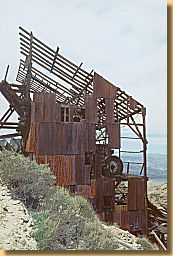
We duly arrived in Skidoo. I found the mill shut down and the pipes all frozen. Al Davis had men trying to thaw out the pipes by wrapping them with waste soaked in distillate, and burning. They were making no headway, as at night it was much colder, although they burned at night also. I tried to get Mr. Montgomery, through telegraph from Mr. Davis, to let me take the pipe apart and lay it out in the sun on the inclined hillside, and let the water run out during the day, and then repipe the mill; but he refused to allow this.
For about two weeks we tried burning the waste over the pipes, and finding it useless, gave up and quit the job. Coming back to Los Angeles, we heard shortly afterward that the mill had burned down.

THE AMALGAMATOR - SKIDOO, 1909
is owned by Jim E. Ehrhart.
[ Previous | Next | Random Site | List Sites | Join]
| © Copyright , Jim E. Ehrhart |
|
Site created & maintained by Bos Graphics. |